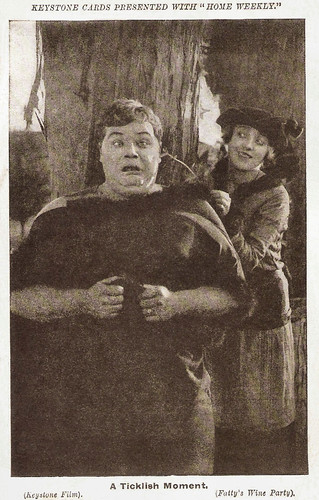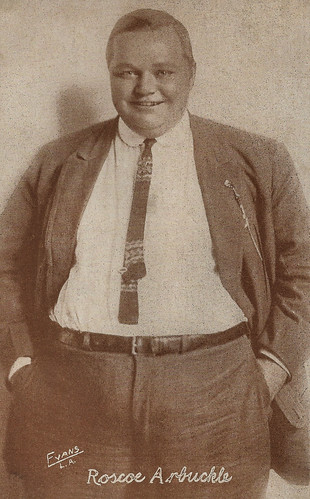
German postcard by Ross Verlag, no. 799/2, 1925-1926. Photo: Phoebus Film.

British postcard in the Pictures Portrait Gallery series, London, no. 9/192.

French postcard by Éditions Filma in the Les Vedettes du Cinéma series, no. 80. Photo: Super-Film.
Bowler hat and pants whose legs were too short
Roscoe Conkling Arbuckle was born in 1887 in Smith Center, Kansas, one of nine children of Mary E. 'Mollie' Gordon and William Goodrich Arbuckle. His family moved to California when he was a year old. Arbuckle had a wonderful singing voice and was extremely agile. At the age of eight, with his mother's encouragement, he first performed on stage with Frank Bacon's company. Arbuckle enjoyed performing and continued until his mother's death in 1899 when he was 12.
His father, who had always treated him harshly, now refused to support him and Arbuckle got work doing odd jobs in a hotel. Arbuckle was in the habit of singing while he worked and was overheard by a customer who was a professional singer. The customer invited him to perform in an amateur talent show. He not only won the competition but began a career in vaudeville.
In 1904, Sid Grauman invited Arbuckle to sing illustrated songs in his new Unique Theater in San Francisco. He then joined the Pantages Theatre Group touring the West Coast of the United States and in 1906 played the Orpheum Theater in Portland, Oregon in a vaudeville troupe organised by Leon Errol. Arbuckle became the main act and the group took their show on tour.
In 1908, Arbuckle married Minta Durfee, who later starred in many early comedy films, often with Arbuckle. Arbuckle then joined the Morosco Burbank Stock vaudeville company and went on a tour of China and Japan returning in early 1909. That year, Arbuckle began his film career with the Selig Polyscope Company when he appeared in Ben's Kid (Francis Boggs, 1909). He appeared sporadically in Selig one-reelers until 1913, moved briefly to Universal Pictures. Then, Arbuckle went to work in producer-director Mack Sennett's Keystone Cops comedies. His character Fatty – he weighed 135 kilograms at the height of his career - usually wore a bowler hat and pants whose legs were too short. For the next 3-1/2 years, he appeared in hundreds of one-reel comedies, mostly as a policeman, but he also played different parts.
He would work with Mabel Normand, and Ford Sterling, and learn about the process of making films from Henry Lehrman, who directed many of his pictures. Despite his massive physical size, Arbuckle was remarkably agile and acrobatic. His comedies are noted as rollicking and fast-paced, have many chase scenes, and feature sight gags. Arbuckle was fond of the ‘pie in the face’, a comedy cliche that has come to symbolise silent-film-era comedy itself. The earliest known custard pie thrown in a film was in the Keystone one-reeler A Noise from the Deep (Mack Sennett, 1913). The pie was thrown by Mabel Normand and Arbuckle was the recipient.

American postcard by Keystone cards, presented with Home Weekly. Photo: Keystone Film. Publicity still for Fatty's Wine Party (Roscoe 'Fatty' Arbuckle, 1914) with Fatty Arbuckle and Mabel Normand. Caption: A Ticklish Moment.

American postcard by Keystone cards, presented with Home Weekly. Photo: Keystone Film. Publicity still for Fatty's Chance Acquaintance ( Roscoe 'Fatty' Arbuckle, 1915) with Billie Bennett.

Chinese postcard, no. 4. Photo: Hartsook Photo, S.F. - L.A. / Keystone Film. Fatty Arbuckle and Mabel Normand in Fatty and Mabel Adrift (Roscoe 'Fatty' Arbuckle, 1916).
A then-unheard-of offer
By 1914 Roscoe Arbuckle had begun directing some of his one-reels. Paramount Pictures made the then-unheard-of offer of US$ 1,000 a day plus 25% of all profits and complete artistic control to make films with Arbuckle and Normand.
The next year he had moved up to two-reels, which meant that he would need to sustain the comedy to be successful - as it turned out, he was. Among his films were Fatty Again (Roscoe 'Fatty' Arbuckle, 1914), Mabel, Fatty and the Law (Roscoe 'Fatty' Arbuckle, 1915), Mabel and Fatty's Wash Day (Roscoe 'Fatty' Arbuckle, 1915), Mabel and Fatty Viewing the World's Fair at San Francisco (Roscoe 'Fatty' Arbuckle, 1915), Fatty's Reckless Fling (Roscoe 'Fatty' Arbuckle, 1915) with Edgar Kennedy, and many more.
Charles Chaplin assisted Arbuckle in The Knockout (Mack Sennett, 1914); and Harold Lloyd was his co-star in Miss Fatty's Seaside Lovers (Roscoe 'Fatty' Arbuckle, 1915). He also hired a young performer he met in New York by the name of Buster Keaton.
Keaton's film career would start with Roscoe in The Butcher Boy (Roscoe 'Fatty' Arbuckle, 1917). Keaton supported him in at least 14 shorts. The films were so lucrative and popular that in 1918 Paramount offered Arbuckle a three-year, $3 million contract ($48,000,000 in 2016 dollars).
In 1916, Arbuckle started his film company, Comique, in partnership with Joseph Schenck. Although Comique produced some of the best short pictures of the silent era, in 1918 Arbuckle transferred his controlling interest in the company to Buster Keaton and accepted Paramount's $3 million offer to make up to 18 feature films over three years. Roscoe's first feature was the Western comedy The Round-Up (George Melford, 1920) and it was successful. It was soon followed by other features, including Brewster's Millions (Joseph Henabery, 1921) and Gasoline Gus (James Cruze, 1921) with Lila Lee.

Spanish minicard in the Escenas selectas de cinematografía series, series B, no. 12, for Juan Garcia, Chocolates Gavilan, Alicante. Roscoe Arbuckle in Moonshine (Roscoe 'Fatty' Arbuckle, 1918). To the right of him, Al St. John as The Mountain Man. With thanks to Steve Massa for the identification.

American Arcade card. Photo: Evans, L.A.
The death of Virginia Rappe
On 5 September 1921, Roscoe Arbuckle took a break from his hectic film schedule and, drove to San Francisco with two friends, Lowell Sherman and Fred Fishback. The three checked into three rooms at the St. Francis Hotel. They invited several women to their suite. During the carousing, a 26-year-old starlet named Virginia Rappe was found seriously ill and was examined by the hotel doctor, who concluded her symptoms were mostly caused by intoxication and gave her morphine to calm her. Rappe was not hospitalised until two days after the incident.
Virginia Rappe suffered from chronic cystitis, a condition that liquor irritated dramatically. Her heavy drinking habits and the poor quality of the era's bootleg alcohol could leave her in severe physical distress. She had undergone several abortions in the space of a few years, and she was preparing to undergo another. At the hospital, Rappe's companion at the party, Bambina Maude Delmont, told Rappe's doctor that Arbuckle had raped her friend. The doctor examined Rappe but found no evidence of rape. Rappe died one day after her hospitalization of peritonitis, caused by a ruptured bladder. Delmont then told police that Arbuckle raped Rappe, and the police concluded that the impact Arbuckle's overweight body had on Rappe eventually caused her bladder to rupture. Delmont later made a statement incriminating Arbuckle to the police in an attempt to extort money from Arbuckle's attorneys.
Arbuckle's trial was a major media event; exaggerated and sensationalized stories ran in William Randolph Hearst's nationwide newspaper chain. The resulting scandal destroyed Arbuckle's career and his personal life. In his testimony, Arbuckle denied he had any knowledge of Rappe's illness. The first trial (14 November-4 December 1921) ended with the jury deadlocked 10 to 2 in favour of acquittal. The second trial (11 January -3 February 1922) also ended in a hung jury; this time the majority had ruled against Roscoe - 10 to 2 for conviction. The third trial (13 March – 12 April 1922) finally ended with an acquittal and a formal statement of apology to Arbuckle for putting him through the ordeal; a dramatic move in American justice.
At the time of his acquittal, Arbuckle owed over $700,000 in legal fees to his attorneys for the three criminal trials, and he was forced to sell his house and all of his cars to pay some of the debt. Although he had been cleared of all criminal charges, the scandal had greatly damaged his popularity among the general public. Will H. Hays ban Roscoe Arbuckle from ever working in U.S. movies again. He also requested that all showings and bookings of Arbuckle films be cancelled.
In December of the same year, under public pressure, Hays elected to lift the ban, but Arbuckle was still unable to secure work as an actor. Buster Keaton signed an agreement to give Arbuckle 35 per cent of all future profits from his company, Buster Keaton Productions, to ease his financial situation. In November 1923, Minta Durfee filed for divorce, charging grounds of desertion. The divorce was granted the following January. Arbuckle married Doris Deane in 1925.

Virginia Rappe. Vintage photo. Collection: Didier Hanson.

Swedish postcard by Forlag Nordisk Konst, Stockholm, no. 865. Photo: Triangle-Keystonefilm.
The magic and youthful spirit of before
Roscoe Arbuckle tried returning to filmmaking, but industry resistance to distributing his pictures continued to linger after his acquittal. He retreated into alcoholism. Buster Keaton attempted to help Arbuckle by giving him work on his films. Arbuckle wrote the story for a Keaton short called Day Dreams (Edward F. Cline, Buster Keaton, 1922). Arbuckle allegedly co-directed scenes in Keaton's Sherlock, Jr. (Buster Keaton, 1924), but it is unclear how much of this footage remained in the film's final cut.
In 1925, Carter Dehaven made the short Character Studies (1927) in which Arbuckle appeared alongside Buster Keaton, Harold Lloyd, Rudolph Valentino, Douglas Fairbanks, and Jackie Coogan. Eventually, Arbuckle was given work as a film director under the alias William Goodrich. Between 1924 and 1932, Arbuckle directed a number of comedy shorts under the pseudonym for Educational Pictures. His films included the Eddie Cantor feature Special Delivery (1927), the Marion Davies vehicle The Red Mill (1927) and Windy Riley Goes Hollywood (1931) with Louise Brooks.
In 1927, he was also engaged to direct and star in a series of comedy shorts for producer Abe Carlos. The films were to be shot in Berlin and distributed internationally, and Arbuckle's wife Doris Deane was to star with him. The films were never produced. In 1929, Doris Deane sued for divorce and Roscoe married Addie Oakley Dukes McPhail in 1931. In 1932, Arbuckle signed a contract with Warner Bros. to star under his own name in a series of two-reel comedies, to be filmed at the Vitagraph studios in Brooklyn. He started with Hey, Pop! (Alfred J. Goulding, 1932).
Tony Fontana at IMDb: “He completed six shorts and showed the magic and youthful spirit that he had a decade before.” These successful films with Al St. John (Arbuckle's nephew) and Lionel Stander constitute the only recordings of his voice. On 28 June 1933, Arbuckle had finished filming the last of the two-reelers, and the next day he was signed by Warner Bros. to make a feature-length film.
That night Roscoe Arbuckle went out with friends to celebrate his first wedding anniversary and new Warner contract where he reportedly said: "This is the best day of my life." He suffered a heart attack later that night and died in his sleep. Roscoe Arbuckle was 46.

French postcard by Edition Paramount, Paris.
The Butcher Boy (Roscoe Arbuckle, 1917) with Fatty Arbuckle and Buster Keaton. Source: Wm. Thomas Sherman (YouTube).
Sources: Tony Fontana (IMDb), Wikipedia and IMDb.
Last updated on 19 April 2023.
No comments:
Post a Comment